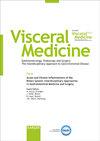Management of Complications Following Emergency and Elective Surgery for Diverticulitis
引用次数: 9
Abstract
Background: The clinical spectrum of sigmoid diverticulitis (SD) varies from asymptomatic diverticulosis to symptomatic disease with potentially fatal complications. Sigmoid colectomy with restoration of continuity has been the prevailing modality for treating acute and recurrent SD, and is often performed as a laparoscopy-assisted procedure. For elective sigmoid colectomy, the postoperative morbidity rate is 15-20% whereas morbidity rates reach up to 30% in patients who undergo emergency surgery for perforated SD. Some of the more common and serious surgical complications after sigmoid colectomy are anastomotic leaks and peritonitis, wound infections, small bowel obstruction, postoperative bleeding, and injuries to the urinary tract structures. Regarding the management of complications, it makes no difference whether the complication is a result of an emergency or an elective procedure. Methods: The present work gives an overview of the management of complications in the surgical treatment of SD based on the current literature. Results: To achieve successful management, early diagnosis is mandatory in cases of deviation from the normal postoperative course. If diagnostic procedures fail to deliver a correlate for the clinical situation of the patient, re-laparotomy or re-laparoscopy still remain among the most important diagnostic and/or therapeutic principles in visceral surgery when a patient's clinical status deteriorates. Conclusion: The ability to recognize and successfully manage complications is a crucial part of the surgical treatment of diverticular disease and should be mastered by any surgeon qualified in this field.憩室炎急诊和择期手术后并发症的处理
背景:乙状结肠憩室炎(SD)的临床谱从无症状憩室病到有症状的疾病,并伴有潜在的致命并发症。乙状结肠切除术并恢复连续性一直是治疗急性和复发性SD的主要方式,通常作为腹腔镜辅助手术进行。择期乙状结肠切除术的术后发病率为15-20%,而因SD穿孔而接受紧急手术的患者发病率高达30%。乙状结肠切除术后更常见和严重的手术并发症是吻合口漏和腹膜炎、伤口感染、小肠梗阻、术后出血和尿路结构损伤。关于并发症的处理,并发症是急诊还是选择性手术的结果没有区别。方法:在文献综述的基础上,对手术治疗SD并发症的处理进行综述。结果:对于偏离术后正常病程的病例,早期诊断是治疗成功的必要条件。如果诊断程序不能与患者的临床情况相关联,当患者的临床状况恶化时,重新开腹或重新腹腔镜检查仍然是内脏手术中最重要的诊断和/或治疗原则。结论:对并发症的识别和成功处理是憩室病手术治疗的关键,任何有资质的外科医生都应掌握这一技能。
本文章由计算机程序翻译,如有差异,请以英文原文为准。
求助全文
约1分钟内获得全文
求助全文

 求助内容:
求助内容: 应助结果提醒方式:
应助结果提醒方式:


